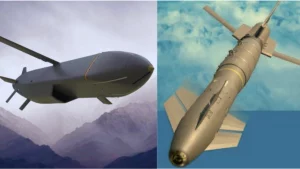Pakistan shivers as these Indian weapons unleash fury in Operation Sindoor

India launched ‘Operation Sindoor’ against Pakistan to avenge the Pahalgam terror attack that killed 26 civilians April 22, 2025. Operation Sindoor became a symbol of the Indian Army’s ability to showcase its strength and technological superiority in every situation not just reactively. In the operation, six weapons were used that created awe and fear in the hearts of the enemy. These powerful weapons proved that India is fully capable of defending itself and facing any challenge.
Akash Missile System
Akash is an indigenous medium-range surface-to-air missile system developed by the Defence Research and Development Organization (DRDO). The system has the capability to destroy targets up to 25 kilometers away with extreme accuracy, and its performance demonstrated the strength of India’s air defense.
Role in Operation Sindoor
Akash missiles were used to destroy enemy drones and other airborne equipment. The system also proved that India’s indigenous defense technology is more effective and powerful than many imported systems.
L-70 Anti-Aircraft Gun
The L70, a radar-guided 40 mm anti-aircraft gun from Sweden, is now equipped with state-of-the-art digital sights and tracking systems. This gun can destroy helicopters, drones, and other low-flying targets with pinpoint accuracy.
Role in Operation Sindoor
India deployed this gun in sensitive areas of Jammu and Kashmir, where it was used especially to destroy enemy drones and quadcopters at night. Its accuracy and capability gave a new edge to India’s defense system.
S-400 Triumph
The S-400 Triumph is a state-of-the-art long-range air defense system manufactured by Russia. It is capable of destroying missiles, aircraft, and drones from a distance of up to 400 kilometers.
Role in Operation Sindoor
The S-400 system secured India’s airspace entirely. When Pakistan attempted to attack Indian cities using Fatah-2 missiles, the S-400 intercepted and destroyed them, proving the robustness of India’s air defense system against any enemy attack.
Rafale + SCALP & HAMMER
Rafale is a 4.5-generation French multi-role fighter aircraft equipped with SCALP and HAMMER missiles. The SCALP missile has a range of about 560 km and can strike key targets without entering enemy airspace.
Role in Operation Sindoor
Rafale jets carried out precision strikes on terrorist launch pads, headquarters, and military facilities in Pakistan. The SCALP missile strikes not only caused physical damage but also had a psychological impact on the enemy, being both unexpected and highly precise.
Su-30MKI + BrahMos
India’s Su-30MKI, a highly capable twin-engine fighter aircraft, is now integrated with the BrahMos-A missile. The BrahMos is the world’s fastest supersonic cruise missile and has significantly boosted India’s air power.
Role in Operation Sindoor
These aircraft used BrahMos missiles to destroy Pakistani military installations. The strikes caused extensive damage to Pakistan’s defense infrastructure and gave the Indian Air Force a major strategic advantage.
IAI Harop
Harop is an Israeli-made loitering munition (or “killer drone”) designed to destroy enemy radars and sensitive installations. This drone is especially effective in targeting and neutralizing air defense systems.
Role in Operation Sindoor
Harop drones targeted Pakistan’s radar systems and communication nodes. Their highly accurate, self-sustaining strikes caused heavy damage to Pakistan’s air defense network, providing a critical tactical advantage to the Indian Air Force.
Operation Sindoor made it clear that India is no longer merely a reactive force, but a proactive, precise, and technologically advanced military power. These six weapons made India’s military machinery stand out and sent a strong message not only on the battlefield but also to the international community that India is now on par with global powers in terms of strategic capability.
News